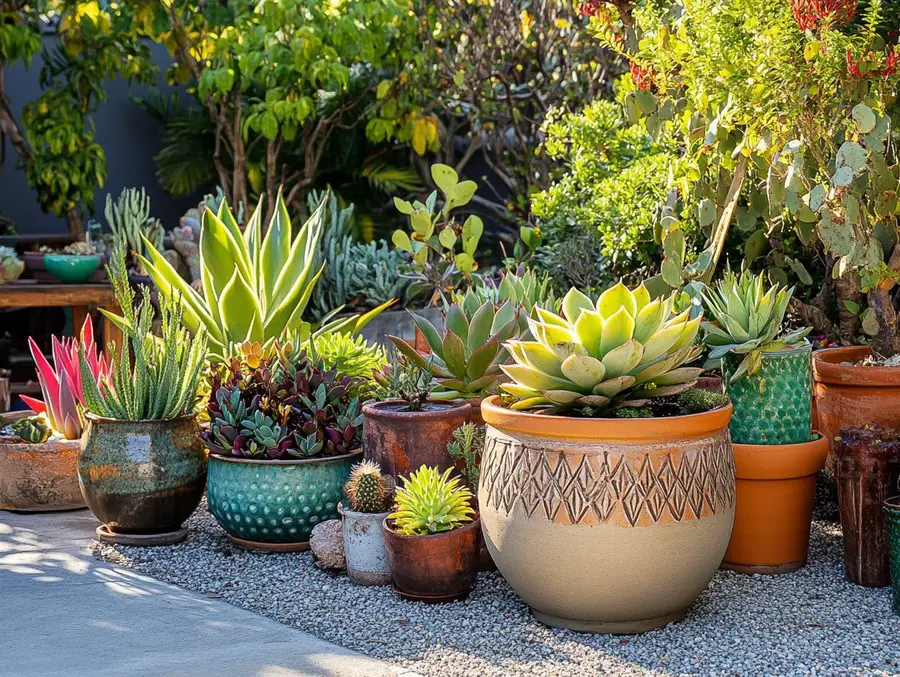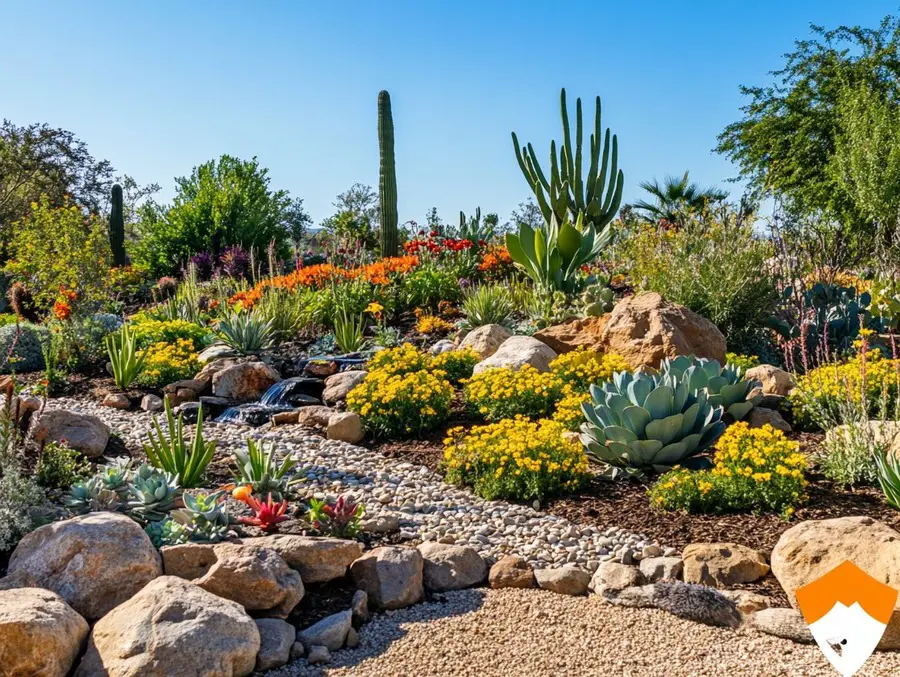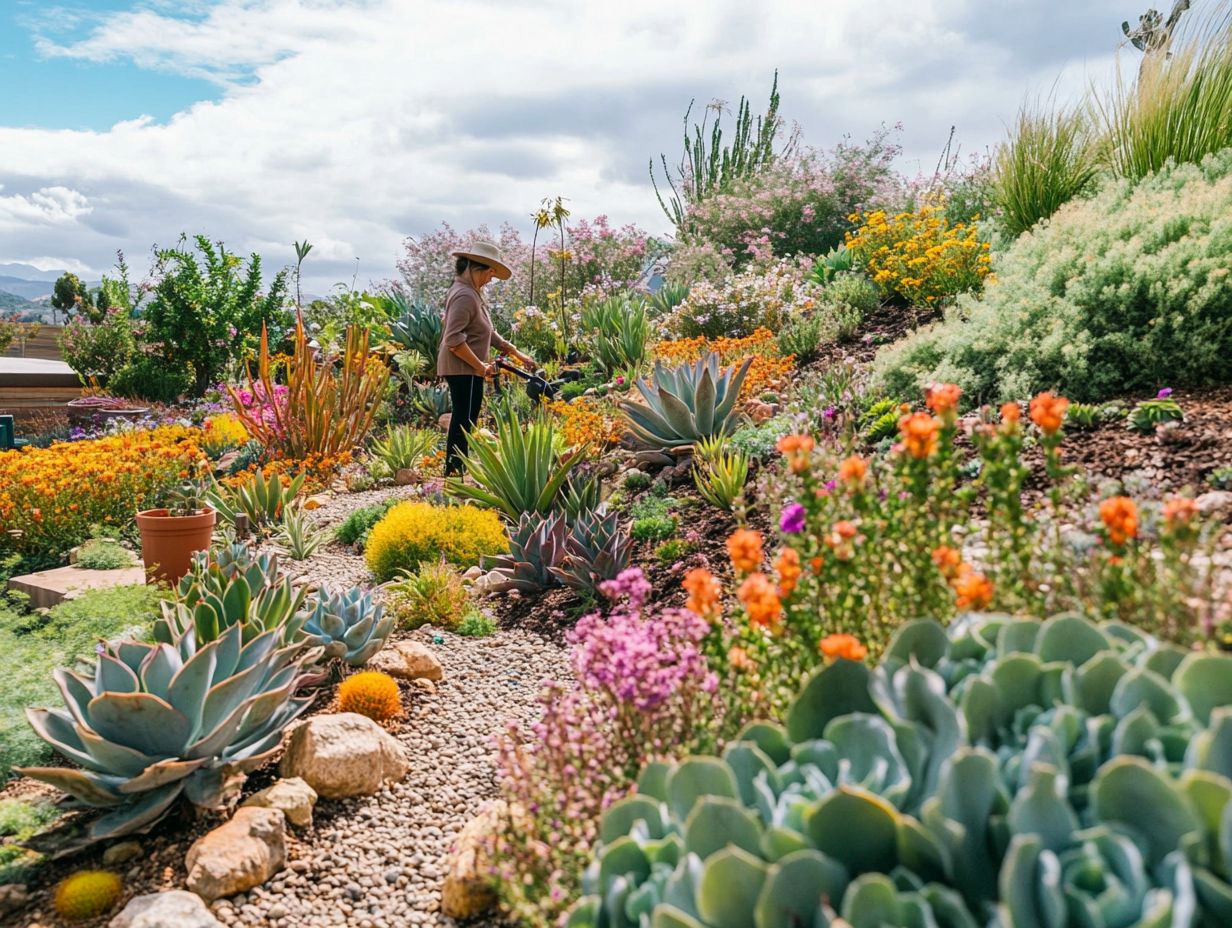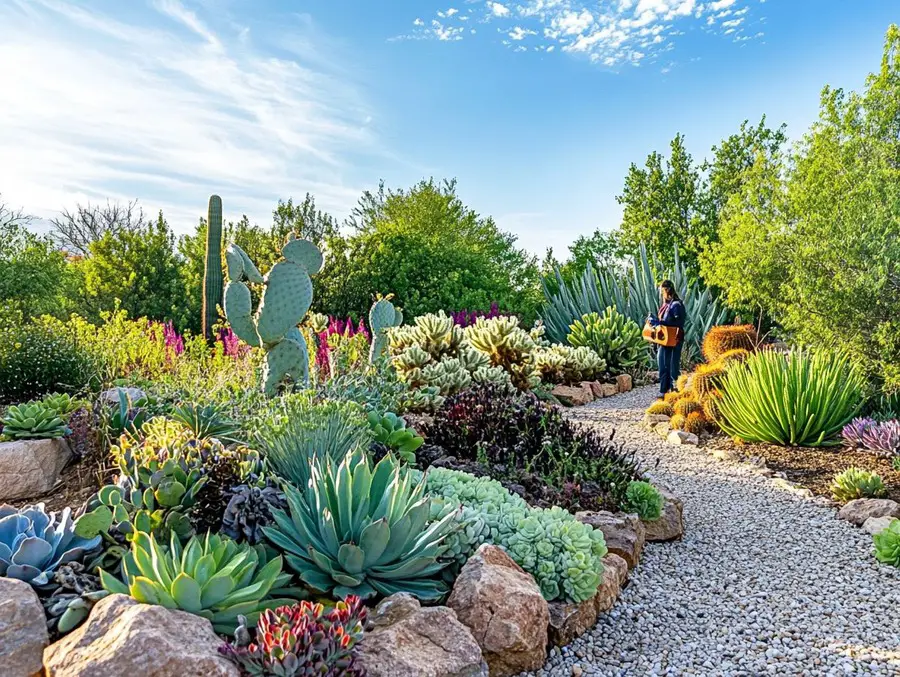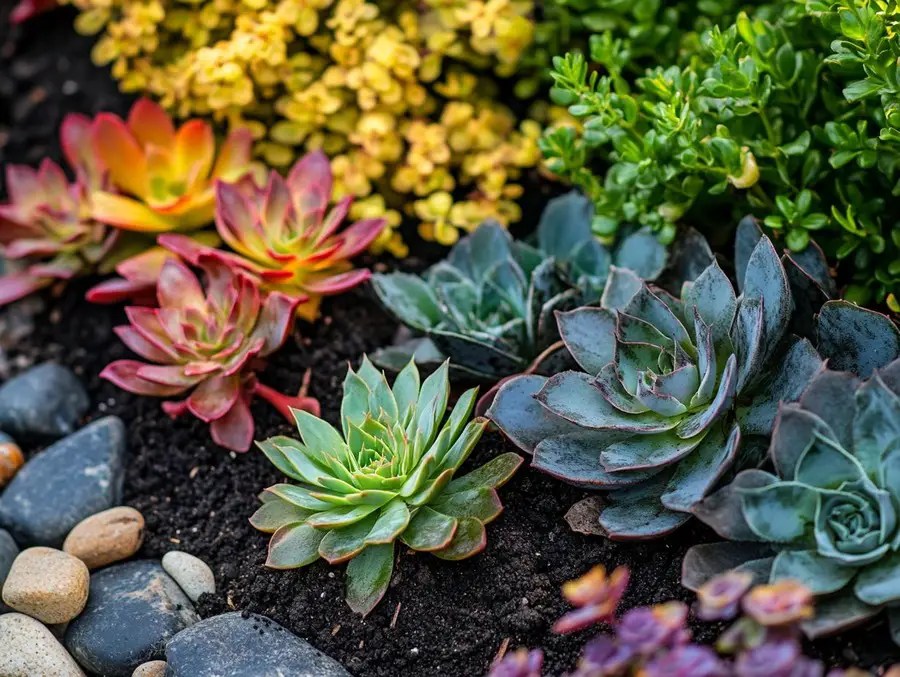We use affiliate links. If you purchase something using one of these links, we may receive compensation or commission.
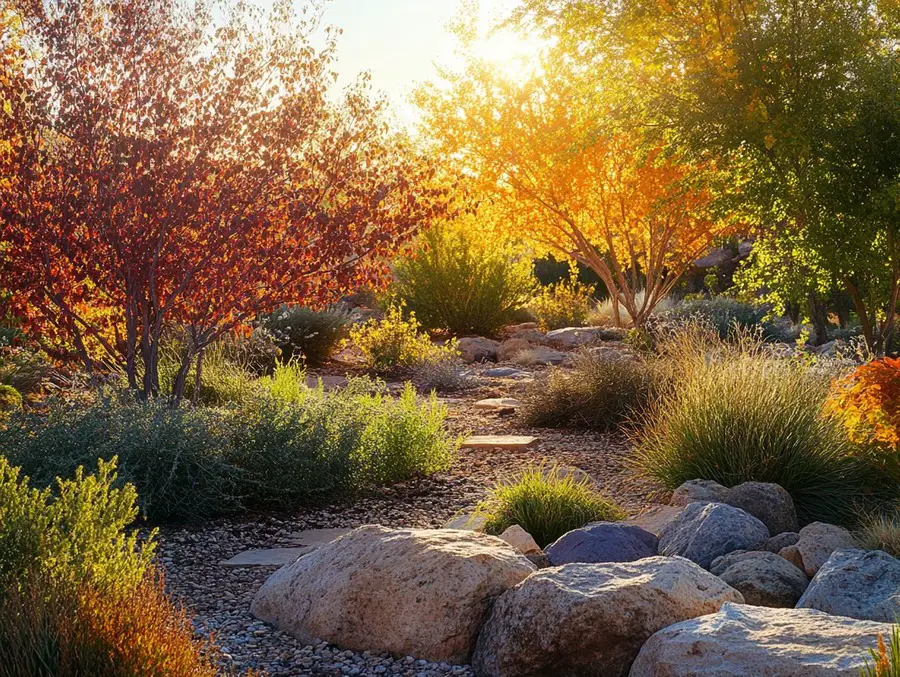
Trees for Xeriscaping are the secret to a lush, water-wise landscape that thrives in dry conditions.
Tired of struggling with high-maintenance greenery in arid climates?
By choosing drought-tolerant trees, you can create natural shade, conserve water, and enhance your outdoor space effortlessly.
Get ready to transform your landscape into a thriving, eco-friendly oasis with the right trees!
Trees for Xeriscaping
Key Takeaways
- Trees for Xeriscaping are drought-tolerant species that require minimal watering while providing shade and enhancing soil health.
- Popular options include mesquite, palo verde, and desert willow.
- These trees thrive in arid climates, reduce water use, and create a sustainable, low-maintenance landscape perfect for conserving resources.
Trees for Xeriscaping: Save Water & Create Shade Naturally
Xeriscaping is a landscaping approach that puts the spotlight on water conservation while still creating beautiful outdoor spaces.
When you incorporate trees into your xeriscaping, you boost the aesthetic appeal and also enjoy some great perks like improved energy efficiency and sustainable water use.
In this article, you’ll explore the advantages of choosing the right drought-tolerant trees, essential planting and maintenance techniques, and how to design a stunning xeriscape that can thrive in arid conditions.
Get ready to discover how to transform your landscape into a vibrant, eco-friendly oasis.
What is Xeriscaping?
Xeriscaping is a fantastic landscaping approach that helps you conserve water and cut down on irrigation needs, making it perfect for those arid climates.
This sustainable gardening method focuses on using drought-resistant plants, like native trees and ornamental shrubs, to create beautiful spaces that require minimal maintenance.
By paying attention to soil types and selecting the right plants, you can craft a thriving xeric garden that looks great, supports biodiversity, and promotes environmental stewardship.
At its core, xeriscaping is all about understanding the unique needs of different soil types, which is key for choosing the right plants.
Since various soils have different drainage capacities and nutrient levels, picking plants that are naturally adapted to your local conditions boosts their chances of thriving.
Using native plants is especially beneficial because they’re already suited to your local climate and pests.
This means you’ll have lower maintenance and higher resilience.
Xeriscaping brings a bunch of environmental perks, like reducing runoff, improving soil health, and supporting local wildlife habitats, all of which contribute to better water conservation and sustainability efforts.
The Benefits of Trees in Xeriscaping
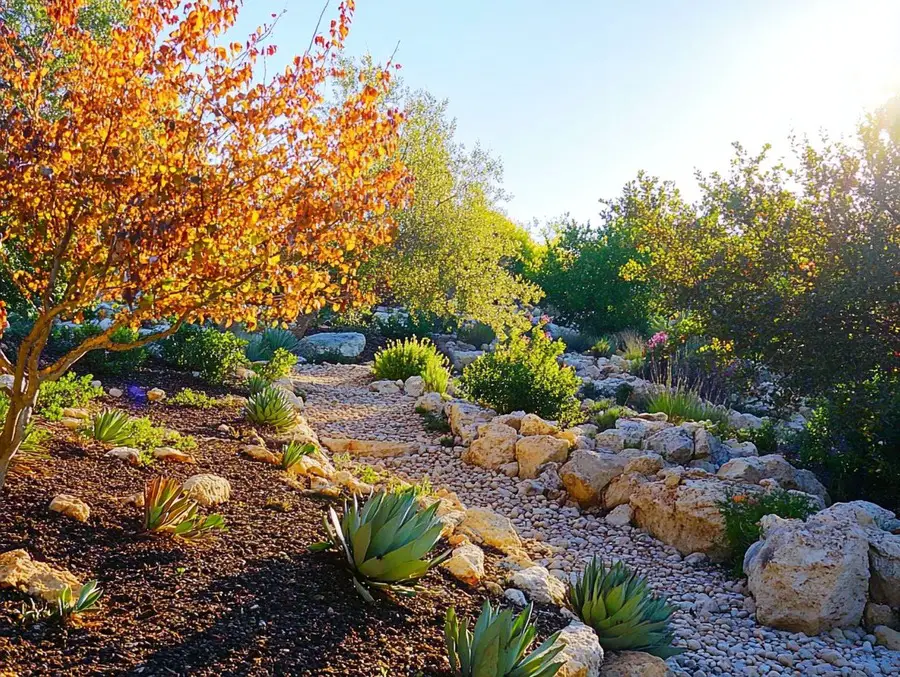 Integrating trees into your xeriscaping design doesn’t just make it look great; it also brings a whole host of environmental benefits.
Integrating trees into your xeriscaping design doesn’t just make it look great; it also brings a whole host of environmental benefits.
Trees, especially low-water and native species, are key players in water conservation and boosting biodiversity in urban areas.
By strategically planting shade trees, you can create little microclimates that help cool things down, manage soil moisture, and provide crucial habitats for wildlife.
Trees are champions of carbon sequestration, helping to lessen the environmental impact of urbanization.
So, they’re really an essential piece of the sustainable landscaping puzzle.
Water Conservation
Water conservation is at the heart of xeriscaping, where your main goal is to use as little water as possible while still keeping your landscape looking vibrant.
You can boost your watering efficiency by using techniques like rainwater harvesting and drip irrigation, making sure your plants, especially those drought-resistant varieties, get the moisture they need without wasting a drop.
By learning about soil moisture conservation strategies and picking the right xeric soil types, you can create a resilient garden that thrives even in dry conditions.
Incorporating soil amendments like organic matter will help improve water retention, allowing the soil to better support the growth of native and drought-tolerant plants.
Preparing the ground with mulch is a great way to reduce evaporation, keeping those roots cool and hydrated.
Using contouring techniques to direct rainwater toward your plants will also help you distribute water more efficiently.
Selecting low-water-use plants is key; these beauties are often well-suited to your local conditions, which means you’re nurturing a healthier ecosystem that requires minimal maintenance and resources.
When you combine these smart strategies, you’ll create a sustainable landscape that can thrive even with limited water availability.
Energy Efficiency
When you implement trees strategically in your xeriscape, you can really boost energy efficiency by creating shade and cutting down on heat in urban settings.
Shade trees work wonders by cooling your home and garden, which can help lower your energy costs and make everything more comfortable.
By creating those little microclimates in your landscape, you can choose heat-tolerant plants that thrive in the shade, making your garden not just beautiful but also sustainable and energy-efficient.
These microclimates are great for promoting diverse plant growth and can help reduce the urban heat island effect, which tends to crank up local temperatures during those scorching months.
By adding in species like Texas sage or desert marigold alongside your well-placed tree canopies, you’ll be promoting a nice environmental balance.
That cooling shade from a thoughtfully designed tree canopy can really lower air temperatures around your structures, which means you won’t have to rely as much on air conditioning.
And let’s not forget that trees help retain soil moisture, which means your drought-tolerant plants will need less water.
This leads to a more vibrant and resilient xeriscape that looks good and works hard for you.
Choosing the Right Trees for Xeriscaping
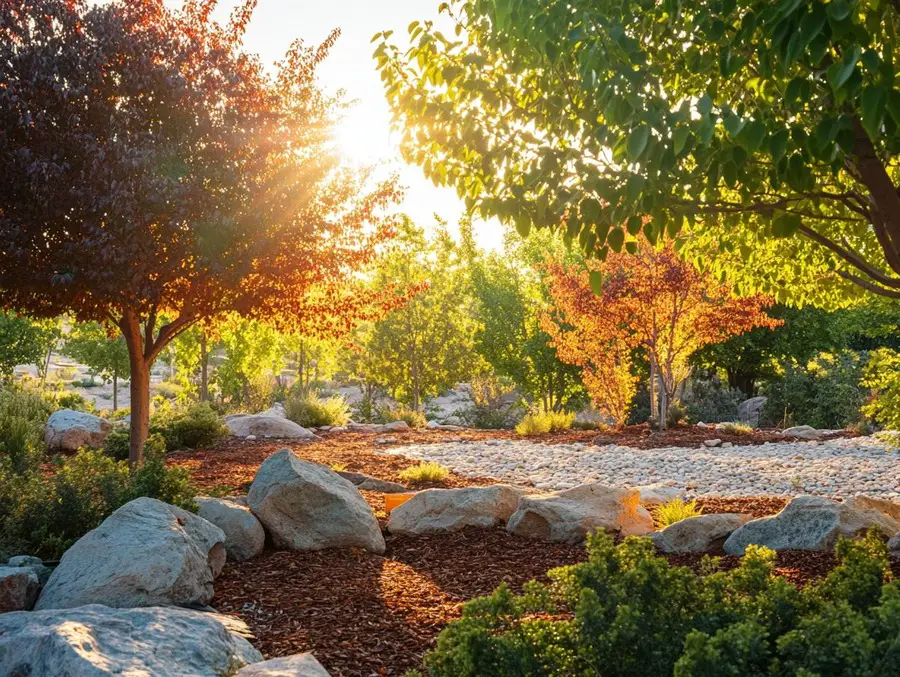 Choosing the right trees for xeriscaping is key to creating a sustainable and thriving landscape that helps with water conservation and boosts biodiversity.
Choosing the right trees for xeriscaping is key to creating a sustainable and thriving landscape that helps with water conservation and boosts biodiversity.
By picking drought-tolerant species and native trees that fit your local climate, you can build a healthy ecosystem that demands minimal maintenance.
Incorporating ornamental trees and low-water varieties can really spice up the visual appeal of your garden while also providing those important environmental benefits.
Drought-Tolerant Species
When you’re picking trees for xeriscaping, it’s crucial to choose drought-tolerant species to create a resilient landscape.
Trees that thrive in low-water conditions, like xerophytes, often have better pest resistance and can adapt to different soil types, making them perfect for sustainable gardening.
Understanding the plant hardiness zones in your area will help guide your choices, ensuring that the trees you select will grow successfully and last a long time.
These drought-tolerant species need less water and help cut down on overall landscape maintenance, which is a win for environmentally-conscious gardeners like you.
For example, native trees such as Mesquite or Palo Verde are fantastic options since they’re well-suited for arid climates and don’t require much irrigation at all.
To figure out the soil types in your garden, you can do some simple pH tests or check in with local extension services.
Matching the right tree species to your local climate is key to establishing a thriving xeriscape, giving you a low-maintenance, beautiful outdoor space that conserves water and looks great!
Adaptability to Local Climate
Understanding how adaptable tree species are to your local climate is key for successful xeriscaping.
When you choose trees that can thrive in your specific environmental conditions, you boost the resilience and sustainability of your landscape.
Think about factors like soil types, temperature extremes, and local rainfall patterns to help you pick the right trees that can withstand climate variations while still looking great.
The right tree species can significantly cut down on water usage, making them a must for eco-friendly landscaping.
Each soil type, whether it’s sandy, clay, or loamy, has its own unique drainage properties, which affect how trees absorb nutrients and moisture from the ground.
By getting a handle on these soil dynamics and considering climatic factors like average seasonal temperatures and humidity levels, you can make informed decisions that benefit each tree’s health and also the overall ecosystem.
By selecting trees that are well-suited to your local conditions, you’ll create a thriving xeriscape that requires less maintenance and conserves those precious water resources.
Planting and Maintaining Trees for Xeriscaping
Proper planting and maintenance techniques are key to ensuring the long-term success of your trees in xeriscaping.
By using effective planting methods, like adding soil amendments and focusing on root system development, you can give your trees the best chance for optimal health and growth.
Regular maintenance practices, such as pruning and keeping an eye out for pests, will help your trees thrive in a low-water environment and contribute to the overall sustainability of your landscape.
Proper Planting Techniques
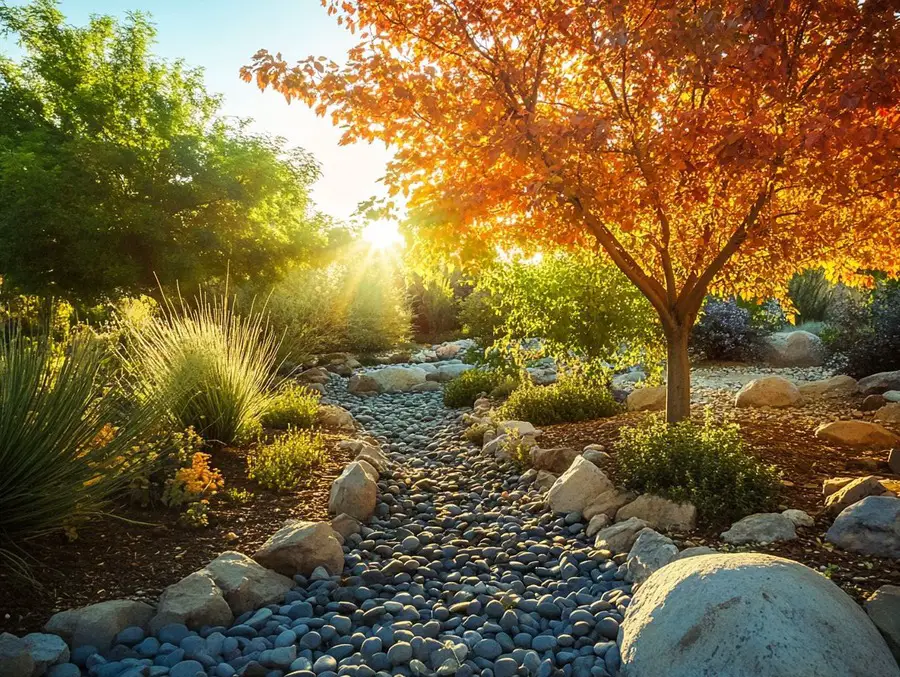
Implementing proper planting techniques is crucial for establishing healthy trees in your xeriscaping project.
Start by preparing the soil with amendments to enhance its structure and fertility, creating the best possible conditions for the roots to thrive.
Understanding how to be efficient with irrigation is key; use drip irrigation methods to deliver water directly to the roots while keeping waste to a minimum during the initial growth phase.
Before you plant, make sure to dig a hole that’s three times wider than the root ball but no deeper than its height.
This allows the roots to spread outwards instead of just going downwards.
Adding organic compost to the native soil will improve drainage and nutrient availability, which is vital for encouraging vigorous growth.
After you’ve placed the tree in the hole, backfill it with the amended soil, gently tamping it down to get rid of any air pockets.
Once your tree is planted, watering techniques become super important; it’s best to soak the area thoroughly so the roots will be encouraged to reach deeper for moisture.
These thoughtful practices boost the tree’s immediate vitality and also play a big role in its long-term health and longevity in your landscape.
Watering and Pruning Tips
Maintaining tree health through proper watering and pruning is super important in a xeriscaped environment.
In terms of watering, think about using efficient methods that help conserve soil moisture and minimize runoff. This way, your trees can establish stronger root systems.
Regular pruning is key too, make sure to remove dead or overcrowded branches to improve air circulation and promote healthy growth.
This will ensure your trees keep thriving in a low-water landscape.
On top of that, consider trying out deep watering strategies that encourage your roots to dig deeper into the soil, which can really boost drought resistance.
Drip irrigation systems can also be a game changer, delivering water right to the roots while cutting down on evaporation losses.
Mulching around the base of your trees helps retain moisture and regulate temperature, which is great for their overall vitality.
Don’t forget about seasonal pruning during dormancy!
It can really enhance tree structure and longevity, allowing for better sunlight exposure and nutrient absorption.
By adopting these tailored techniques, you can keep your xeriscaped landscape looking vibrant and resilient, no matter what challenges come your way.
Creating a Xeriscape Design with Trees
Creating a xeriscape design that incorporates trees can really transform your landscape into a sustainable and visually appealing space.
By thoughtfully choosing design elements that work well with the surrounding environment, you can boost urban greening efforts while promoting biodiversity.
Using trees adds beauty and also provides essential ecosystem services that help keep your landscape healthy.
Incorporating Trees into a Drought-Resistant Landscape
Incorporating trees into your drought-resistant landscape takes a bit of strategic planning, but it’s totally worth it to make sure they match the overall vibe and functionality of your garden.
By using companion planting techniques and picking tree species that thrive in the same conditions, you can enhance the ecological balance and create a welcoming habitat for wildlife.
This thoughtful approach elevates your landscape design and also aligns with the sustainable practices of xeriscaping.
To get started, think about planting native species like mesquite or ironwood.
They need less water and offer essential shelter and food for local critters.
Pairing these trees with drought-tolerant shrubs like sage or prickly pear will help you create a multi-layered environment that boosts moisture retention and keeps your soil healthy.
Mixing up your planting patterns reduces competition for resources and attracts beneficial insects and pollinators.
By crafting a varied ecosystem, you can integrate trees in a way that yields a resilient landscape thriving even in tough conditions.
Frequently Asked Questions
What does xeriscaping mean?
Xeriscaping is a landscaping technique that focuses on using drought-resistant plants and materials to create a sustainable and low-maintenance garden.
Why should I consider using trees for xeriscaping?
Trees provide many benefits in xeriscaping, such as shading and wind protection, reducing water evaporation, and creating a natural habitat for wildlife.
They also add beauty and character to the landscape.
What are the best types of trees for xeriscaping?
The best types of trees for xeriscaping are those that are native to your region and can thrive in dry and hot conditions.
Some popular options include desert willows, palo verde, and mesquite trees.
How should I care for trees in a xeriscaped garden?
Proper care for trees in a xeriscaped garden includes regular watering until they are established, mulching to retain moisture, and pruning to remove dead or damaged branches.
It is also important to monitor for pests and diseases.
Can I still have a lush and green garden with xeriscaping?
Yes, xeriscaping does not mean sacrificing a beautiful and green garden.
By choosing the right trees and other plants, strategically placing them, and implementing efficient irrigation methods, you can create a lush and sustainable oasis in your yard.
Are there any tips for designing a xeriscaped garden with trees?
When designing a xeriscaped garden with trees, consider the mature size of the trees, their water and sun requirements, and their placement in relation to other plants and structures.
Grouping trees with similar needs together can also help with efficient watering.
Best Plants for Xeriscape Gardens: Hardy & Beautiful
Xeriscape Garden Styles: Easy Low-Maintenance Options
Xeriscape Gardening Techniques: Easy Low-Water Tips
Xeriscape Garden Design & Layout: Easy Water-Wise Beauty
What is xeriscaping? A beginner’s guide to drought-tolerant landscaping – Colorado State University
Related Content
Visit my Amazon Influencer Page for videos and gardening products Grow Your Own Garden

